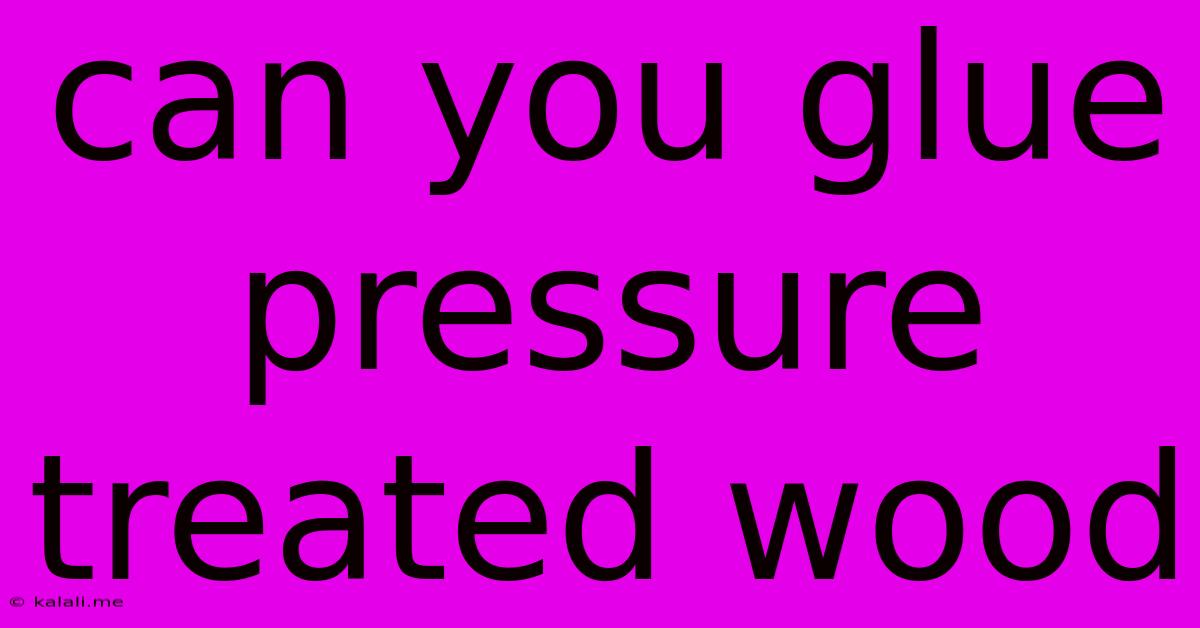Can You Glue Pressure Treated Wood
Kalali
May 25, 2025 · 4 min read

Table of Contents
Can You Glue Pressure Treated Wood? A Comprehensive Guide
Meta Description: Learn whether you can glue pressure treated wood and discover the best glues, preparation methods, and potential challenges to ensure a strong, lasting bond. This guide explores the complexities of working with this type of lumber.
Pressure-treated wood is a popular choice for outdoor projects due to its resistance to rot, decay, and insect infestation. However, the chemicals used in the pressure treatment process can complicate gluing. This article explores the feasibility of gluing pressure treated wood, examining the best glues, preparation techniques, and potential problems you might encounter.
Understanding Pressure Treated Wood
Before diving into gluing techniques, it's crucial to understand the nature of pressure treated lumber. The treatment process involves forcing preservatives, often containing copper, chromium, and arsenic (CCA) or other less-toxic alternatives like copper azole (CA-B) and copper quaternary (CuQ), deep into the wood's pores. These chemicals protect the wood, but they can also interfere with adhesive bonding. The type of preservative used significantly impacts the glueability of the wood. Older CCA-treated lumber is generally more difficult to glue than newer, less-toxic treated lumber.
Can You Glue It? The Short Answer: Yes, But…
Yes, you can glue pressure-treated wood, but it requires careful consideration and the right approach. The success of the bond depends heavily on proper surface preparation and the selection of an appropriate adhesive. Simply using any old glue will likely result in failure.
Choosing the Right Glue
Not all glues are created equal when it comes to pressure-treated wood. Some glues are better suited to withstand the chemical environment and create a strong, long-lasting bond. Consider these options:
-
Construction Adhesives: Exterior-grade construction adhesives, often labeled as waterproof or weatherproof, are a good starting point. These adhesives are formulated to be more resistant to moisture and chemicals than standard wood glues. Look for those specifically designed for exterior use and potentially those that advertise good adhesion to treated lumber.
-
Epoxy Adhesives: Epoxy glues offer exceptional strength and are less susceptible to the negative effects of the preservatives in pressure-treated wood. They're a more expensive option, but their superior bond strength often justifies the cost, particularly for projects demanding high durability.
Preparing the Wood for Gluing
Proper preparation is paramount to achieving a successful glue bond with pressure-treated wood. Follow these steps:
-
Clean the Surfaces: Thoroughly clean the surfaces to be glued. Remove any dirt, dust, debris, mold, or mildew. Use a wire brush or sandpaper to create a rough surface, increasing the surface area for better adhesion.
-
Dry the Wood: Ensure the wood is completely dry before applying glue. Excess moisture can significantly weaken the bond.
-
Pre-treat the Surface (Optional): For older CCA-treated lumber or if you are concerned about chemical interference, consider lightly sanding the surfaces to remove some of the surface preservative. However, avoid excessive sanding, as it can weaken the wood.
Gluing Techniques and Considerations
-
Apply Glue Liberally: Don't skimp on the glue. Apply a generous amount to both surfaces, ensuring complete coverage.
-
Clamp Firmly: Use clamps to apply even pressure and hold the pieces together while the glue cures. Adequate clamping pressure is essential for a strong bond.
-
Cure Time: Allow ample time for the glue to fully cure. Check the manufacturer's instructions for the recommended cure time. This can vary depending on the type of adhesive used, temperature, and humidity.
-
Expect a Less Strong Bond: Even with proper preparation, the bond strength on pressure-treated wood may not be as strong as that achieved with untreated lumber. Take this into account when designing your project.
Potential Challenges and Troubleshooting
-
Chemical Interference: The preservatives in pressure-treated wood can interfere with the adhesive's ability to bond effectively. Proper surface preparation and the right glue choice are critical in mitigating this issue.
-
Moisture Content: High moisture content in the wood can weaken the bond. Ensure the wood is properly dried before gluing.
-
Glue Failure: If the glue bond fails, it's likely due to improper preparation, incorrect glue selection, or insufficient clamping pressure.
By carefully selecting the appropriate glue, thoroughly preparing the wood surfaces, and following proper gluing techniques, you can successfully glue pressure-treated lumber for many outdoor projects. However, always prioritize safety and be aware of the potential challenges involved. Remember to consult the manufacturer’s instructions for your chosen adhesive for specific recommendations and safety precautions.
Latest Posts
Latest Posts
-
Can You Substitute Butter With Vegetable Oil
May 26, 2025
-
Do You Capitalize With In A Title
May 26, 2025
-
Cosine Of A Normal Random Variable
May 26, 2025
-
What Does Raca In Bible Mean
May 26, 2025
-
What Does Blessed Are The Poor In Spirit Mean
May 26, 2025
Related Post
Thank you for visiting our website which covers about Can You Glue Pressure Treated Wood . We hope the information provided has been useful to you. Feel free to contact us if you have any questions or need further assistance. See you next time and don't miss to bookmark.